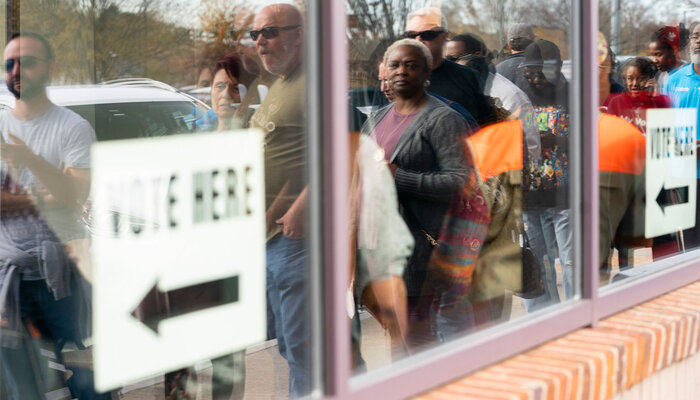Ten years ago, the Supreme Court eviscerated a central component of the Voting Rights Act in Shelby County v. Holder. That decision removed the requirement for jurisdictions with histories of racial discrimination in voting to obtain federal approval for new voting policies — a process called “preclearance.” Without this guardrail, voters lost a bulwark against discriminatory voting policies, and states previously subject to preclearance were free to implement discriminatory restrictions on voting access without advance checks. Many states did exactly that.
Along with a prior decision narrowly interpreting constitutional protections for voting rights, Shelby County also sent a message to the nation that the federal courts would no longer play their historic role as a robust protector of voting rights. In the years since, the Court has repeatedly confirmed this, signaling to states that they could pass restrictive voting laws without fear of legal consequence. (The Supreme Court’s recent decision in Allen v. Milligan upholds the Voting Rights Act’s protections against racial gerrymandering, not against voting restrictions.)
As a result, the country has witnessed a barrage of restrictive voting legislation over the course of the last decade, reaching a fever pitch after the 2020 election and showing no signs of abating. (While the trend of restrictive voting legislation began before Shelby County, its effects were largely mitigated by the preclearance process and court decisions that blocked or blunted new measures to curtail voting access.)
The Brennan Center has been tracking and cataloging this trend of restrictive voting legislation from its inception. Legislation is categorized as restrictive if it contains one or more provisions that would make it harder for eligible Americans to register, stay on the voter rolls, or vote as compared to existing state law.
Since Shelby County was decided, at least 29 states have passed 94 restrictive voting laws. While a few of these have been blocked by courts or repealed, most are still in effect, and at least one continues to operate in each of the 29 states.
At least 29 laws were passed in 11 states that had been subject to preclearance, either in whole or in part, at the time Shelby County was decided. In other words, if not for the Supreme Court’s decision, approximately one-third of the restrictive laws passed in the last 10 years would have been subject to pre-approval by the Justice Department or a panel of federal judges, and many of them may have been barred from implementation. Indeed, several of those laws were later struck down or enjoined as racially discriminatory. But others continue to pose barriers to the ballot box.
Not all restrictive laws are created equal — some, like those passed in Iowa, Florida, Georgia, and Texas in 2021, are omnibus bills that include many restrictive provisions. Still, it is notable that at least 7 states have passed 5 or more restrictive laws since the Shelby County decision. Arizona, a state that was previously subject to preclearance, clocks in with the highest number of restrictive voting laws (8) passed in any one state since Shelby County. On the other hand, some states have enacted one or two restrictive provisions but, on balance, have expanded voting access more than they’ve restricted it in the past 10 years. Among such states are New Jersey, New Mexico, New York, and Utah.
Many of these new laws are racially discriminatory. There is ample evidence that these kinds of laws fall hardest on communities of color, and a number have been struck down by courts as racially discriminatory. The gaps between turnout rates for white voters and voters of color have grown in the years since Shelby County, including in jurisdictions previously covered by preclearance. Research also suggests that many of these laws may have been passed with racially discriminatory purpose, as some courts have also found. Far from racial discrimination in voting being a specter of the past, as the Shelby County opinion presumed, there is ample evidence that it continues to play an active role in the continued suppression of voters of color.
The restrictive laws passed in the last 10 years target every aspect of voting, including making voter registration more difficult, curtailing early voting opportunities, closing polling places, and limiting voter assistance. However, a substantial portion of the restrictive laws passed since Shelby County coalesce around two major trends: strict voter ID legislation just after the decision and limitations on mail voting after the 2020 election.
Immediate and persistent focus on voter ID
The first wave of restrictive laws following Shelby County was largely focused on imposing unreasonably strict voter ID requirements. In fact, the very day that the Supreme Court released its decision, the Texas attorney general announced that a strict voter ID law previously blocked by preclearance for its discriminatory impact would become effective immediately. Federal courts later struck down the law as racially discriminatory under another provision of the Voting Rights Act.
Mississippi and Alabama also began to enforce photo ID laws that had previously been blocked under preclearance. The North Carolina legislature passed an omnibus voting bill that instituted a strict voter ID requirement and several other restrictive policies — a bill that a federal court later found “target[ed] African Americans with almost surgical precision.”
This trend of instating stricter voter ID requirements or restricting acceptable forms of voter ID continued through 2017, with at least nine states post-Shelby County enacting new restrictive voter ID laws (including the North Carolina law discussed above) or implementing voter ID laws previously barred by preclearance.
Perhaps as a result of numerous successful legal challenges, strict voter ID laws became less common five years after Shelby County. But since 2021, some state legislatures have once again turned their focus to the policy. At least nine states have enacted at least 13 restrictive voter ID laws for in-person voting in the last three years, including three states that had previously done so in the years immediately following Shelby County.
There is a growing mountain of evidence that strict voter ID laws disproportionately impact voters of color. Strict voter ID requirements also place burdens on voters with disabilities and low-income voters who can face significant obstacles to obtaining photo identification.
Overall, at least 25 new laws implementing restrictive voter ID policies have been passed since Shelby County. (A number of these 25 laws rolled back voting access in other ways as well.) While a number of these laws were struck down in whole or in part for being racially discriminatory, many would likely never have been implemented under preclearance. The number of voters who were disenfranchised while lawsuits progressed and while many of these laws continue to be in effect — especially voters of color — is immeasurable.
Mail voting targeted after 2020
More recently, lawmakers seeking to restrict access to voting have focused on voting by mail. The United States has a long history of mail voting that dates back to before the nation’s founding. In the immediate aftermath of Shelby County, very few restrictive laws targeting mail voting passed. In fact, many states actively expanded mail voting options. However, the lies about mail ballot voter fraud that were spread during and after the 2020 race, coupled with the role mail voting played in expanding voter turnout in 2020, prompted an extreme legislative backlash against mail voting. Since the 2020 election, 21 states passed 33 laws restricting mail voting access. Overall, 22 states passed 43 such laws since Shelby County. (A number of these bills restricted voting access in other ways as well.)
For any voter, and especially those who have travel obligations, health needs, transportation challenges, or job conflicts, restricting mail voting can hinder them from easily participating in democracy. Some of these new restrictions have a clear racially discriminatory impact. For example, the Brennan Center studied a 2021 Texas law requiring a voter to include their driver’s license number or the last four digits of their social security number on mail ballot applications and mail ballots and requiring the number to match the individual’s voter file data. During Texas’s March 2022 primary, thousands of mail ballots and mail ballot applications were rejected, disproportionately cast by Latino, Asian, and Black voters. Overall, nonwhite voters were at least 30 percent more likely to have an application or mail ballot rejected than white voters.
In short, Shelby County v. Holder opened the floodgates for restrictive voting laws. The Supreme Court’s ruling was based on a claim that racial discrimination in voting was largely a thing of the past, but the story that has unfolded in the years since belies that claim. Over the last decade, voters have faced an unprecedented slew of restrictive and often discriminatory laws, and the courts have offered little in the way of protection.
As the Supreme Court noted in Shelby County, Congress can remedy this problem. And it should — by passing the John R. Lewis Voting Rights Advancement Act to restore the Voting Rights Act to its full strength, as well as the Freedom to Vote Act to set nondiscriminatory baseline national standards for voting and elections.
UPDATE: The number of laws restricting mail voting access has been updated since initial publication. Clarifications were also added, noting that some restrictive voting laws have been repealed or struck done and that certain states have passed both expansive and restrictive voting laws.







